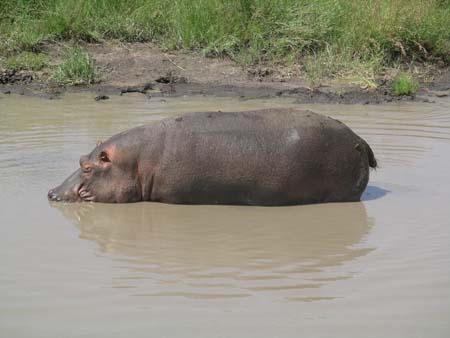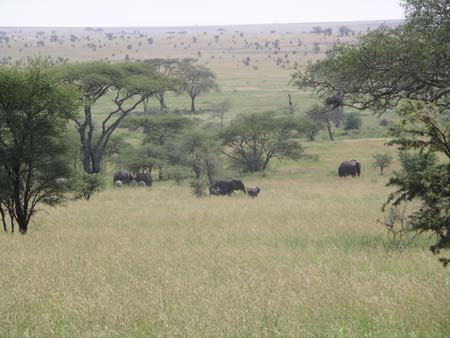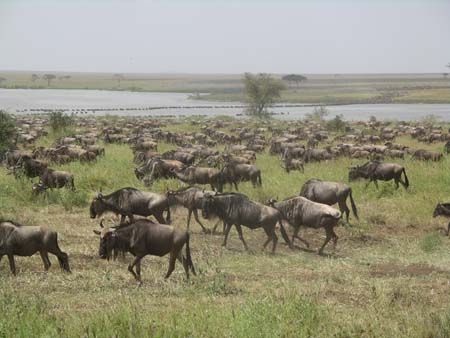Tuesday, May 25
Steve: Nassibu suggested that for our second full day in the Serengeti we explore the area to the southwest, where we had seen the wildebeest headed yesterday. He thought that perhaps we would have opportunities to see larger herds of migrating animals - this sounded great to us.
After another beautiful sunrise and breakfast, we packed our picnic lunches and headed out. The road south through the Serengeti has become quickly familiar to us. The initial part is heavily wooded, and is where we have seen many giraffes, impalas, topi and baboons. This was also where we found the solitary elephant bull yesterday. Fresh elephant droppings on the road this morning had us optimistic about perhaps seeing him again today, but our search led to no avail. Seeing many of the animals requires a fair bit of luck, as we have found that a single tree or patch of grass can easily hide something even when it's very close to the road.
 After
the woodlands, we enter a section where the road hugs a small river - we have
found that this area houses a wide variety of wildlife, and today we saw several
giraffes, topi, hippos and impalas. Predictably, since we have now seen several
of the same animals multiple times, we stop much less frequently to observe
and take pictures. However, we did pause to snap photographs at one particularly
pretty scene with a small harem of impalas in front of a watering hole.
After
the woodlands, we enter a section where the road hugs a small river - we have
found that this area houses a wide variety of wildlife, and today we saw several
giraffes, topi, hippos and impalas. Predictably, since we have now seen several
of the same animals multiple times, we stop much less frequently to observe
and take pictures. However, we did pause to snap photographs at one particularly
pretty scene with a small harem of impalas in front of a watering hole.
After cutting west and then heading south, we found ourselves on a new road
leading through vast open areas of grass. We saw no one else anywhere - it
was just us and our  Land
Rover in the middle of beautiful plains that stretched to the horizon in all
directions. Huge and solitary acacia trees dotted the landscape. This was
Africa
Land
Rover in the middle of beautiful plains that stretched to the horizon in all
directions. Huge and solitary acacia trees dotted the landscape. This was
Africa  exactly
as we pictured it!
exactly
as we pictured it!
We drove for probably 30 minutes without seeing any wildlife, but Nassibu
didn't seem concerned. Our first sighting was a solitary hippo lounging in
a small pool of mud right beside the road. The hippo cooperated by standing
up so we could get a better sense for his full size and  take
pictures. We're still hoping for one of those classic shots where a hippo
yawns and shows off his impressive teeth.
take
pictures. We're still hoping for one of those classic shots where a hippo
yawns and shows off his impressive teeth.
Next we spotted an elephant bull on the road, and just as we began to admire him Nassibu told us that there was actually a very large herd of elephants that he could see in the distance. We are constantly amazed at Nassibu's ability to spot these sorts of things even with his bare eyes - we probably never would have seen them even if we had been scanning with binoculars. In any case, we quickly left the bull and headed to a point where we could get a view of the larger group.
From our spot on the road, we were able to count at least 70 elephants, most
in groups with small babies. Since elephants generally  travel
in families of 10-15, we were looking at multiple families all grazing and
moving slowly to the north. Even at a distance, the size of these animals
is very evident, and it's really spectacular to see them in the wild. We watched
the elephants grazing for quite some time, and then Nassibu told us that he
could hear wildebeest in the distance. Sure enough, just barely audible to
us, we could also hear the wildebeest's distinctive "gnu gnu" sound
emanating from just over a hill. We weren't sure of the size of herd that
we would find, but it sure sounded large…
travel
in families of 10-15, we were looking at multiple families all grazing and
moving slowly to the north. Even at a distance, the size of these animals
is very evident, and it's really spectacular to see them in the wild. We watched
the elephants grazing for quite some time, and then Nassibu told us that he
could hear wildebeest in the distance. Sure enough, just barely audible to
us, we could also hear the wildebeest's distinctive "gnu gnu" sound
emanating from just over a hill. We weren't sure of the size of herd that
we would find, but it sure sounded large…
Yesterday we thought we had experienced what the "migration of the herd"
was all about, but we didn't realize that we really hadn't seen anything yet.
As we passed over the crest of a hill, an absolutely enormous herd of animals
appeared before us, stretching literally for as far as we could see. We also
had a view of Lake Magadi in the distance, and were able to make out a long
line of wildebeests  that
were actually crossing right through the middle of the lake. Behind them was
a huge backup of animals, all apparently waiting their turn to swim across.
that
were actually crossing right through the middle of the lake. Behind them was
a huge backup of animals, all apparently waiting their turn to swim across.
We drove slowly toward the lake, and quickly found ourselves literally in the middle of a huge herd with animals that ran out of the road and started mini-stampedes as we approached. The closer we got to the lake, the more we were able to see all the various paths that the animals were taking as they headed north. While some were crossing the lake (the line of animals is visible in the pictures of the lake below), there were also several other large groups that were making their way around both sides. One of those herds was stampeding directly in front of us on the west side of the lake, and we stopped the Land Rover by a small river where huge numbers of animals had gathered.

The sounds, sights and smells were unbelievable. The clamor from so many
wildebeests all making their "gnu gnu" noises was really amazing.
Of course, the stench of so many animals and the flies that they attract are
not pleasant, but we were so excited to be right in the middle of the migration
that it didn't matter.  As
we watched from our spot by the river, it appeared that the wildebeests were
totally in disarray. One group would start stampeding frantically for no apparent
reason in one direction, then stop suddenly to eat, rest or look around. Then
another herd would do the same thing, but heading a totally different way.
We had to keep reminding ourselves that there must be an overall sense of
order that governs this whole phenomenon, but today it was often very hard
to see.
As
we watched from our spot by the river, it appeared that the wildebeests were
totally in disarray. One group would start stampeding frantically for no apparent
reason in one direction, then stop suddenly to eat, rest or look around. Then
another herd would do the same thing, but heading a totally different way.
We had to keep reminding ourselves that there must be an overall sense of
order that governs this whole phenomenon, but today it was often very hard
to see.
We drove down to the lake to get a closer view of the wildebeest crossing right through the middle. Nassibu told us that in his 17 years of viewing wildlife in the Serengeti, he had never seen this happen here! It was a spectacular sight, and one that we will always remember.
We decided to drive south toward where the migration was coming from, and the further we drove, the more wildebeest we saw. Soon it becam=e clear to Nassibu that we were in the middle of the major portion of the entire annual Serengeti migration. He estimated that we were looking at well over 1 million animals, probably 50% of the estimated total 2 million wildebeest that live in the Serengeti!









We stopped for lunch at one of the few places where people are able to leave the safety of their vehicles (we weren't exactly sure why, since it seemed like a prime place for lions…) high on the Moru Kopjes, an outcropping of rocks with great views of the herds of wildebeests below. Even from this distance, the sounds were unbelievably loud. The views from the rocks gave us an even better appreciation for the immense size of these herds as we could see the black dots of animals stretching far beyond Lake Magadi toward the north, and then also as far as we could see toward the south. As we ate our lunch, we reflected on how long we had been talking about seeing this migration, and how we never could have hoped for a more perfect experience than the one we were having at that moment.
We were actually in for one more treat today as Nassibu excitedly handed
us the binoculars after scanning the horizon for himself. He told us that
he had just spotted the first black rhino that he had ever seen in the Serengeti,
and we quickly were able to view the huge animal for ourselves. The black
rhino is seriously endangered, and there are only 12 living  here
in the entire Serengeti. Although the rhino was quite a distance from us,
it was easy to make out its distinctive horn and large body. Nassibu explained
that the rhinos are all tracked carefully by park rangers, and sure enough
we soon saw a truck making its way out to the rhino apparently to make sure
that he was in good health. We were all thrilled to have seen the rhino, and
Nassibu congratulated us on now having seen all of the "Big 5" (rhino,
elephant, lion, buffalo and leopard) in just our first three days here. In
particular, he told us that the rhino and leopard are the hardest of this
group to see, and many people come and go without ever spotting these elusive
animals.
here
in the entire Serengeti. Although the rhino was quite a distance from us,
it was easy to make out its distinctive horn and large body. Nassibu explained
that the rhinos are all tracked carefully by park rangers, and sure enough
we soon saw a truck making its way out to the rhino apparently to make sure
that he was in good health. We were all thrilled to have seen the rhino, and
Nassibu congratulated us on now having seen all of the "Big 5" (rhino,
elephant, lion, buffalo and leopard) in just our first three days here. In
particular, he told us that the rhino and leopard are the hardest of this
group to see, and many people come and go without ever spotting these elusive
animals.
Our drive back included a "normal" array of impalas, giraffes,
hippos, baboons, and ostriches. We also saw the same elephant bull from earlier
today, as well as a large black cobra that coiled up and appeared to want
to lunge at our Land Rover as we passed by. Even the long drives here are
a real treat, since we never know what we are going to see next. The special
feeling of driving along and suddenly seeing a family of beautiful giraffes
quietly grazing on tall trees or a troop of baboons watching us cautiously
from the side of the road is something we hope that we'll never forget.
Seeing the migration of the herds in the Serengeti has always been one of things we have been looking forward to the most. In fact, this specific event had a significant impact on the timing of our trip to Tanzania (and therefore other components of our travel as well). It was also something where we knew that there were no guarantees, regardless of how much planning and preparation was done. We feel extremely fortunate to have witnessed what we did today in its entire splendor - this was very special and will most certainly result in a very lasting memory for us all.

David's Daily Dump: First Impressions of the Serengeti. Our first couple
of days out here in the Serengeti has been spectacular. The animals especially
have been magnificent. I can't describe what it feels like to see giraffes
and elephants for the first time in the wild. It's a wonderful feeling. The
Serengeti has not only met my expectations but also exceeded them. The scenery
with the wide open plains, lonely trees, and golden grass is unforgettable.
My favorite things from our first day were the leopard, giraffes, hyenas and baboons. We also were able to see the huge migration of herds of wildebeests in the plain which was really cool. On the second day, we followed one of these herds as they drank from a stream, and avoided a hunting crocodile. We also saw lions, elephants, hippos and an ostrich! I can't wait to explore more of Tanzania and see more wildlife (we haven't yet seen a rhino) as well as the unique tribal cultures.
Animals seen on 5/25:
Giraffe
Baboon
Impala
Ostrich
Grant's Gazelle
Topi
Hippo
Nile Crocodile
Wildebeest (over 1 million)
Bat Eared Fox
Elephant
Spitting Cobra Snake
NEW Birds seen on 5/25:
Grey Horned Bill
Black-White Whita
White-Headed Buffalo Weaver
Red Billed Ox Pecker
Buzzard
Flap Rock Bird
Starlings
Grey Back Fisto
